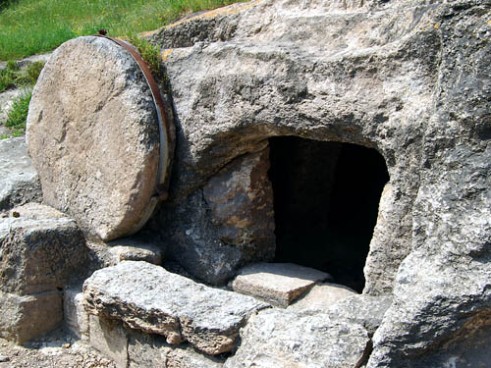
Remembering the cross of Christ, as well as the crucifixion (for clarification, see yesterday’s post) is crucial to our understanding of the atonement, but it isn’t the whole story. That’s likely why I’ve never really liked the old hymn “The Old Rugged Cross”. I get the point, it’s a big part of our faith, but it’s only the beginning. There’s all sorts of metaphors we can make about the piercing of his side and the fact that it remained open, shades of how Adam’s side was opened for the bride to come out. Isn’t it great that Jesus’ side was left open?
You see, we also need to remember to cling to the old dusty grave. Something happened in that grave, something larger than we can ever imagine. Paul says that during the cave time of Jesus, he descended into Hades, and led captivity captive. Thousands of years of Christian tradition have trivialized the grave of Christ, turning his descent into Hades into nothing more than a quaint little phrase we say, usually only on Easter, sometimes on Good Friday, but not nearly enough.
So what was that grave?
The grave of Christ is not just about death of the physical body, some mysterious place where all our physical infirmity was somehow taken away. No, the grave represents the very darkest parts of our human experience. Depression, sadness, loneliness, bitterness, hurt, anger, suicide, murder, rage. That is the grave of Christ. It’s the same cave we all live in from time to time, and the message of that cave (and the grave) is: Jesus has descended into Hades. And not just the metaphorical Hades of lore, but the literal place where our depression leads. The solitude and loneliness produced by death (whether spiritual or otherwise).
This depression and anger, fear and hatred, murder and rage—the darkest places of our human experience—Jesus used as his port of origin to set sail into the endless seas of human darkness. From all time to all time, he stepped into the inevitable result of our insistence to remain in darkness and laid hold of all that we are, or ever could have been.
There’s an Icon that shows Jesus’ descent into Hades, where he has gone through the ages and laid hold of Adam and Eve by the wrist, to signify that they couldn’t have done it, so he needed to. Christ has taken hold of anything that would tell us we are trapped in the darkness and evil of self deceit. Paul tells us he led captivity captive, and elsewhere that the he emptied hades.
Emptied. EMPTIED!
Do we understand that? Christ has descended into the fruit of our darkness and pain, laid hold of any means of scapegoating our anthropology for that darkness, and brought the host of hades out with him. A parade of violence and rage was led forth, and transformed into life and love. He has emptied all the power held in blaming our past. He has emptied all the power held in surrendering to “original sin”. He has emptied all the power held in any sort of exclusion or injustice. Jesus has rendered death, life. He has rendered injustice, justice. He has rendered rage, peace.
The grave is not just a temporary holding place for the body of the messiah. It is the summarization of what we could become if darkness was our destiny.
But it isn’t.
The grave is the place where sin and sorrow meet, where death and depravity culminated in the darkest moment of the atonement, literally and figuratively.
And just as each Easter we are reminded of the choice between the Jesus of Peace and the Jesus of Violence, we are also reminded that the grave is a choice. A choice to believe that the doubt, arrogance, anger and defeat are not the end of the story. For after that comes the descent. His descent into our hell proves to us that there is nowhere He won’t go for us. No business he won’t set foot in. No sin that can separate us. No fear that can hold us. No power that can defeat us. Not because “we” are powerful, we are frail. But in our frailty, his strength was made perfect.
The grave is the symbol that—just as we see in Luke 15—the power that frees us is the same power that is utterly unwilling to do without all that we are and all that belong to him.
